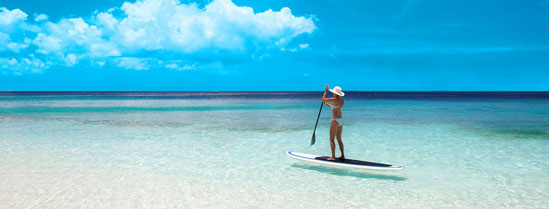A Beginner's Guide to Using Stand Up Paddle
Introduction
Powered by the paddler, stand-up paddling, abbreviated as SUP, is an excellent cardio workout that and a wonderful stress reliever. SUP’s most stated health benefit is the improvement to a person’s core. Featuring an easy learning curve, sup is a fantastic way of improving overall fitness, irrespective of what shape you currently are in now. If you are fascinated by this ever-growing sport, here is a beginner’s guide on how to use a stand up paddle board.
How to Stand Up On Your SUP
If this is your first attempt at this sport, the best thing is to start out in calm, flat waters that don’t have obstacles like buoys and boats.
When starting out, you may find that it’s easier to kneel rather than stand upright. Below are steps for getting started:
• Standing in shallow water alongside the board, put the paddles on the deck of the paddleboard and use this as an outrigger. The paddle grip is located on the board’s rail, with the blade resting on the water.
• Use the rails to hold the board. Your other hand will be hosting the grip of the paddle.
• While in a kneeling situation, climb onto your board, just behind the board’s center point.
• From the position of kneeling, try to get the balance point of the paddling board. Its nose need not pop up out of the water. In the same way, the tail should not dig in.
• To stabilize the board, maintain your hands on each side of the board.
• When you are ready stand upright on the board, one foot at a time. Put your feet in the position that your knees were. You may want to bring your friend to help in stabilizing the board as you learn to stand on it.
How to Turn a Paddle Board
There are many straightforward ways of turning a paddle board.
• Sidestroke: This method involves just paddling on one side until such a time that the nose turns in the way you want to go. To turn right, you will need to paddle on the left, and if you want to go left, just paddle right. This makes a winding arcing turn.
• Backpaddle: A quicker way of reversing or turning direction is to just drag the paddle backward on each side of your board.
• Sweep stroke: Position your paddle in the direction of the front end of the board. Take one long sweeping stroke towards the tail and away from your board. The board will move in the opposite direction to the stroke.
How to Paddle
• Your feet need to face forward approximately hip distance apart, with slightly bent knees.
• To help keep balance, make sure your core is kept engaged.
• Hold the top part of your paddle with one hand, with the other hand being placed at a comfortable distance roughly midway down the paddle.
• The paddle angle needs to face away from you
• Make sure your arms are straight as you extend the paddle onward for each stroke.
• Make four-to-five short, and close strokes on every side of the board and then change sides and reverse the hand position.
How to Stop
Stopping the paddle is a breeze. All you need to do is to put your paddle in a vertical position into the water.
When You Fall
While stand up paddle boarding isn’t a tough thing to learn, expect to fall occasionally as you gain skills. For the inevitable times that you lose balance:
• Ensure that the depth of the water you’re paddling in is at least shoulder deep, as this ensures that you will not hit bottom when you do fall.
• Aim to one side to fall into the water as opposed to falling onto the board. You will most likely be injured if you fall onto the board.
• In case you get parted from your board and paddle, make efforts to get your board first and then paddle it to get back the paddle.
Conclusion
One thing that makes SUP so popular is the fact that, with respecting precautions and laws and knowing conditions, is that it’s a safe sport for people of all athletic ability, ages, and sizes. This is a pastime that will be enjoyed by every member of the family. Once you’ve made the first investment, you can be sure of the inexpensive delight of the great outdoors.





